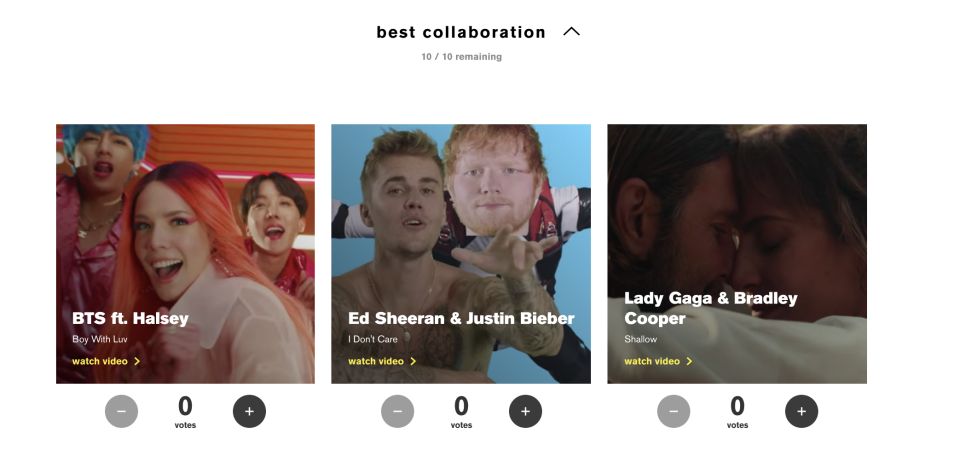MTV VMAs' New K-Pop Category Is Another Way to Marginalize Successful Non-White Artists Like BTS and BLACKPINK
In this op-ed, writer Aamina Khan discusses the impact of the MTV VMAs adding a new K-Pop category to the 2019 ceremony, and argues that it further separates non-White artists from the main awards like Video of the Year.
Missy Elliott once referred to the MTV Video Music Awards as “the white people’s awards.” The rapper was overheard saying the phrase during her 1997 New Yorker profile in reference to her nervousness around her performance at the VMAs that year. But the sentiment has continued to echo in the decades since — through culturally appropriative performances, through Nicki Minaj’s call-outs of racial inequality in the nominees, through the fact that Beyoncé’s “Formation” was the first time a Black artist won Best Pop Video.
Her words are now echoing again in the 2019 VMAs nominations announcement, in which MTV shared that a new category would be added: Best K-Pop. The nominees in the category include: BTS ft. Halsey for “Boy With Luv,” BLACKPINK for “Kill This Love,” Monsta X ft. French Montana for “Who Do U Love,” TOMORROW X TOGETHER for “Cat & Dog,” NCT 127 for “Regular,” and EXO for “Tempo.”
At first glance, the K-Pop category sounds like a positive, or at least neutral, addition meant to “reflect the rich pop music landscape,” as Bruce Gillmer, Head of Music and Music Talent at MTV International said in a statement. But as the past 24 hours of reactions from actual K-Pop fans have shown, despite good intentions, the impact of a K-Pop category is more layered and nuanced than that. The new category just reiterates a tendency in Western awards shows to “celebrate” non-Western, non-English speaking, non-white artists by separating them away from their accepted, non-othered counterparts.
The BTS ARMY has taken a particularly strong stance against this year’s nominations and categories. BTS is nominated for four awards, including Best K-Pop, Best Collaboration, Best Art Direction, and Best Choreography. Despite these accolades, fans were quick to notice BTS’s absence in the core honors: Video of the Year, Artist of the Year, and Song of the Year. In response, the ARMY started trending #VMAsRacist and #VMAsXenophobic — with the point that any artist with the music video views, album sales, and tour numbers of BTS’ would have been nominated for Album of the Year and Video of the Year with no second thought.
Awards obviously honor more than just YouTube music video views, but by that measure the numbers prove interesting. Consider this year’s Video of the Year nominees: “a lot” by 21 Savage ft. J. Cole (156 million views), “Bad Guy” by Billie Eilish (407 million), “thank u, next” by Ariana Grande (402 million), “Sucker” by Jonas Brothers (182 million), “Old Town Road (Remix)” by Lil Nas X ft. Billy Ray Cyrus (230 million), and “You Need to Calm Down” by Taylor Swift (91 million).
In the K-Pop category, several of the videos honored have comparable (and even higher) numbers: “Boy With Luv” (470 million views), “Kill This Love” (500 million), and “Tempo” (127 million). And yet there is no K-Pop nominated in Video of the Year.
K-Pop also isn’t alone there — in the Best Latin category, Bad Bunny’s collab with Drake, “Mia,” currently has 869 million views. Benny Blanco, Tainy, Selena Gomez, and J. Balvin’s “I Can’t Get Enough” has 147 million. Anuel AA and Karol G’s “Secreto” has 755 million. Maluma’s “Mala Mía” has 277 million. “Con Altura” from ROSALÍA and J. Balvin ft. El Guincho has 597 million. Daddy Yankee ft. Snow’s “Con Calma” has more than 1.2 billion views.
None received Video, Song, or Artist nominations this year.
The VMAs aren’t the only awards show to group music awards by geographic location, but these decisions feel particularly out of place in a fan-voted award show that’s known for its big cultural moments. The fact that no K-Pop or Latin category-nominated artist was nominated in the three main areas, the fact they don’t even get to compete against artists with comparable (and in most cases, much fewer) viewing and sales numbers feels like an insult.
Add to that the smaller slights that have cropped up in the VMAs K-Pop category rollout, like the fact that only one girl group is nominated in K-Pop, despite stateside popularity for other groups like LOONA. Then there’s the official MTV Twitter account, which congratulated French Montana for the K-Pop nomination, not even mentioning Monsta X in the tweet. And when you go to MTV’s site to vote in the categories, the BTS voting thumbnail centers on Halsey, who only features on the track. (Halsey is one of the nominees for Artist of the Year.)

K-Pop popularity has skyrocketed to mainstream relevancy in the U.S. these past few years, so it’s understandable to want to highlight BTS and other immensely successful K-Pop groups, especially for an event like the VMAs that saw an all time low in viewership for the last two years. (Meanwhile, BTS member J-Hope had 9.6 million live viewers when he counted down to his birthday in a livestream earlier this year.) But the details around these nominations sound like they’re saying, “You can come, just don’t sit with us.”
In 2015, Nicki Minaj’s “Anaconda” broke Vevo records and was nominated at the VMAs for Best Female Video and Best Hip-Hop Video. It was not nominated for Video of the Year. Nicki took a stand on Twitter: “When the ‘other’ girls drop a video that breaks records and impacts culture they get that nomination,” she said at the time.
Her words sound familiar.
Let us slide into your DMs. Sign up for the Teen Vogue daily email.
Want more from Teen Vogue? Check this out: Criticism of BTS Is Often Just Xenophobia in Disguise
Originally Appeared on Teen Vogue

